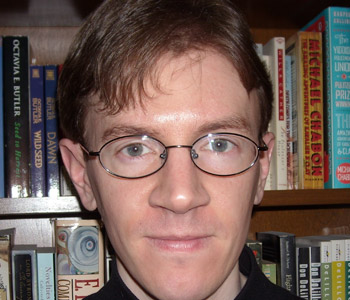Mark Driscoll
Absolute Erotic, Absolute Grotesque: The Living, Dead, and Undead in Japan’s Imperialism, 1895–1945
Duke University Press
352 pages, 9 x 6 inches
ISBN 978 0822347408
ISBN 978 0822347613
This book is the first comprehensive treatment of Japan’s imperialism that emphasizes the crucial aspects of sexuality, desire and labor beginning around 1880 and ending with the nuclear terrorism of Hiroshima and Nagasaki.
Until now, the scholarship on Japan’s imperialism has both marginalized sexuality and tended to configure the contours of J-imperialism as something that was basically copied from Western templates of modern capitalist development, then got out of hand when Japan turned on its Western mentors and started a war against the US/UK in Asia and the Pacific. My book rejects this Eurocentric assumption and situates Japan fully in Asia; in particular, I focus on the inter-state rivalry between Japan and China.
The book begins with the first full historical discussion of the throngs of Japanese pimps and drug traffickers working in the expanding treaty ports in China and Southeast Asia. These were the most influential early Japanese imperialists—not the West-worshipping intellectuals like Fukuzawa Yukichi who have tended to receive the most attention from scholars. These traffickers were the first Asians to successfully compete against the dominant position that Chinese merchants enjoyed in the region for 800 years.
I also focus on something that has never been discussed in previous treatments of Japanese imperialism in either English or Japanese: the fact that North Chinese coolies from Shandong and Hebei did all the physical labor for Japanese colonial and capitalist enterprises in Northeast China (Manchuria) and in Japan’s colonies elsewhere. The Japanese didn’t physically build anything, but they super-exploited the Chinese men and women who did. Japanese capitalists took advantage of the ecological, political and economic problems in Central and North China during the late Qing Dynasty era, which caused some 20 million desperately poor Chinese to migrate to Manchuria, a historical phenomenon I call after the Middle Passage of African slaves across the Atlantic, the “Manchurian Passage.”
The most important feature of the book is probably the emphasis on sex work and non-normative forms of erotic expression and the ways in which Japanese sexologists and erotic-grotesque writers naturalized them. In addition to coolies and Japanese pimps/human traffickers, between 30,000 and 60,000 young Japanese women, most of them kidnapped, were brought to Asia from 1885-1920 to do sex work in the booming Japanese commercial areas in Korea, Northeast China, Shanghai, Hong Kong and Singapore. The appeal they had for male consumers (represented in Madam Butterfly) led these same consumers to buy Japanese food, liquor, and other merchandise and stimulated a general “desire” for things Japanese.
Almost all countries had banned human trafficking by 1910, but important Japanese leaders decried the ban as Christian erotophobia and, as non-Christians, they opposed it and its assumptions of universality. Popular Japanese sexologists writing in the 1920s argued strongly that East Asia since 800 AD had always had sex districts and pleasure quarters and in fact wouldn’t be East Asia without them. Unfortunately, this contributed to the so-called comfort women system, where anywhere from 150,000 to 300,000 women were trafficked as sex slaves by Japanese militarists beginning in the early 1930s.
The last section of the book, “Necropolitics,” returns to Asia to demonstrate what happened to Chinese coolies, peasants and sex workers in a more extreme form of imperial domination.

Between 30,000 and 60,000 young Japanese women, most of them kidnapped, were brought to Asia from 1885-1920 to do sex work in the booming Japanese commercial areas in Korea, Northeast China, Shanghai, Hong Kong and Singapore. The appeal they had for male consumers led these same consumers to buy Japanese food, liquor, and other merchandise and stimulated a general 'desire' for things Japanese.
In addition to my new interpretation of Japanese sexology and sex practices in Asia, the three middle chapters of the book focus on the most commercially popular of Japan’s mass culture in the 1920s—“erotic-grotesque” modernism.
Similar to both Weimar culture in Germany and the Jazz Age in the US, Japan’s erotic-grotesque writers, artists, and performers downloaded the understanding of East Asian sexuality from Japanese sexologists like Tanaka Kôgai as completely opposed to the erotophobia of the Christian West. Therefore, the representation of sexuality in Japan’s erotic-grotesque modernism was much more celebratory and promotional than in the West. However, these codes of sexuality gradually became more extreme and sensationalistic. Partially out of the need of publishers and writers to compete in an urban marketplace that was obsessed with the new and bizarre, they came to feature necrophilia, cannibalism and sadism as regular themes.
This is important because I think that—ironically, since many producers were in fact Marxists or highly critical of colonial militarism—this culture of the erotic-grotesque ended up contributing to the atrocities that Japanese men committed in China and Southeast Asia.
Up until my book, scholars have largely understood the crimes against humanity that Japanese forces committed in WW II as caused by a kind of culture of militarism going back almost 1,000 years. I strongly disagree. In the book I make the case that the consumer capitalism of the erotic-grotesque contributed much more to atrocities like the Rape of Nanjing than Japan’s “timeless” military culture.
As far as the professional and political path that led me to working on East Asian cultural history, I went to graduate school in cultural studies and intellectual history in the late 1980s and early 1990s when the critique of Eurocentrism was strong. I decided to work on Japan and China at this point and learned both Japanese and Chinese, eventually getting a Ph.D. from Cornell University in 2000.
What I found was that because of the Cold War alliance between Japan and the United States, scholars in the West almost completely whitewashed what Japanese imperialists had done in Asia. Obviously, this contrasted with what Chinese scholars were saying.
I attended a protest against the Japanese emperor in California in the summer of 1994. The information in the US media surrounding his visit was outrageously false. For example, the New York Times reporter from Tokyo, Nick Kristof, who is now a regular op-ed columnist, stated at this time that 300,000 Chinese had died in WWII, a number he learned at Yale University where he was an East Asian studies major. In other words, the accepted “story” consolidated in elite universities in the US about Japan’s wars in Asia almost completely repressed information about atrocities against the Chinese. This fact led Iris Chang to write The Rape of Nanjing—and scholars now acknowledge that an estimated 21 million Chinese died in WWII.
In the book I try to reveal other things that have been long repressed and silenced by scholars in Japan and the West—but that are known by the general public in China. And my book is now being translated into Chinese.
This book is primarily an academic historical exercise and I have used some fairly abstract and philosophical language to describe what I see as the three distinct phases of Japanese imperialism.
However, readers interested in more concrete history would probably enjoy flipping around the first part of the book called “Biopolitics” where I discuss in some detail Japan’s colonization of Taiwan, Korea, and south Manchuria.
The middle chapters (5 and 6) feature the first in-depth discussion of Japan’s “erotic-grotesque” modernism, looking at perverse detective novels and left-wing pornography. I also discuss some of the key subjectivities of Japanese modernism like the modern girl, modern boy and detective writer.
The Intertext after chapter 6 analyzes the interesting novels of the popular Japanese detective writer Edogawa Rampo. It also treats the boom in vampires in Japan beginning in the late 1920s—attempting to provide an historical rational for why vampires became so popular at this time.
For readers interested in the lead-up to the second Sino-Japanese War and imperialist war in general, the last section of the book, “Necropolitics,” would be the best place for browsing.
In this section I try to show what happens to some of the main historical actors who appeared in the first section of the book as they become enmeshed in a very different form of imperialist politics. Focusing on Japan’s Manchukuo colony, I argue through Frantz Fanon and Achille Mbembe that the final stage of Japan’s imperialism must be seen as invested in killing and immobilizing. I show the ways in which Japanese imperialists turned to drug and human trafficking in massive numbers, which financed the two-front wars Japan was fighting against China and against the US and UK in the Asia-Pacific.
In addition to over 20 million Chinese killed during this war, an estimated 10 million became drug addicts through Japan’s systematized dealing of heroin and opium. In some areas of Japan’s colony of Manchukuo, 30-40% of Chinese were drug addicts; this in places where drugs had been almost completely eradicated in the 1920s.

The mass culture of the erotic-grotesque ended up contributing to the atrocities that Japanese men committed in China and Southeast Asia.
Informed readers in the West often are perplexed by the overwhelmingly hostile attitude that most Chinese (and Koreans as well) have towards Japan. Lacking much historical information about what Japanese imperialists did in China and Asia, many Westerners are left feeling that lingering hostility towards Japan can only be explained by a kind of irrationality in the Chinese psychic sensibility. I hope my book will help Western readers better understand this hostility.
Second, I hope that informed Western readers see the horrors of Japanese imperialism as not that different from what English colonialism unleashed in Central and East Asia via the opium trade or from what the US has recently done in Iraq. In this way, I try not to “other” Japanese imperialism as deviant and different but show it was structurally similar to other instances of imperialist aggression.




We don't put paywalls. We don't distract you with ads. We don't sell your data.
Please help to keep this running!